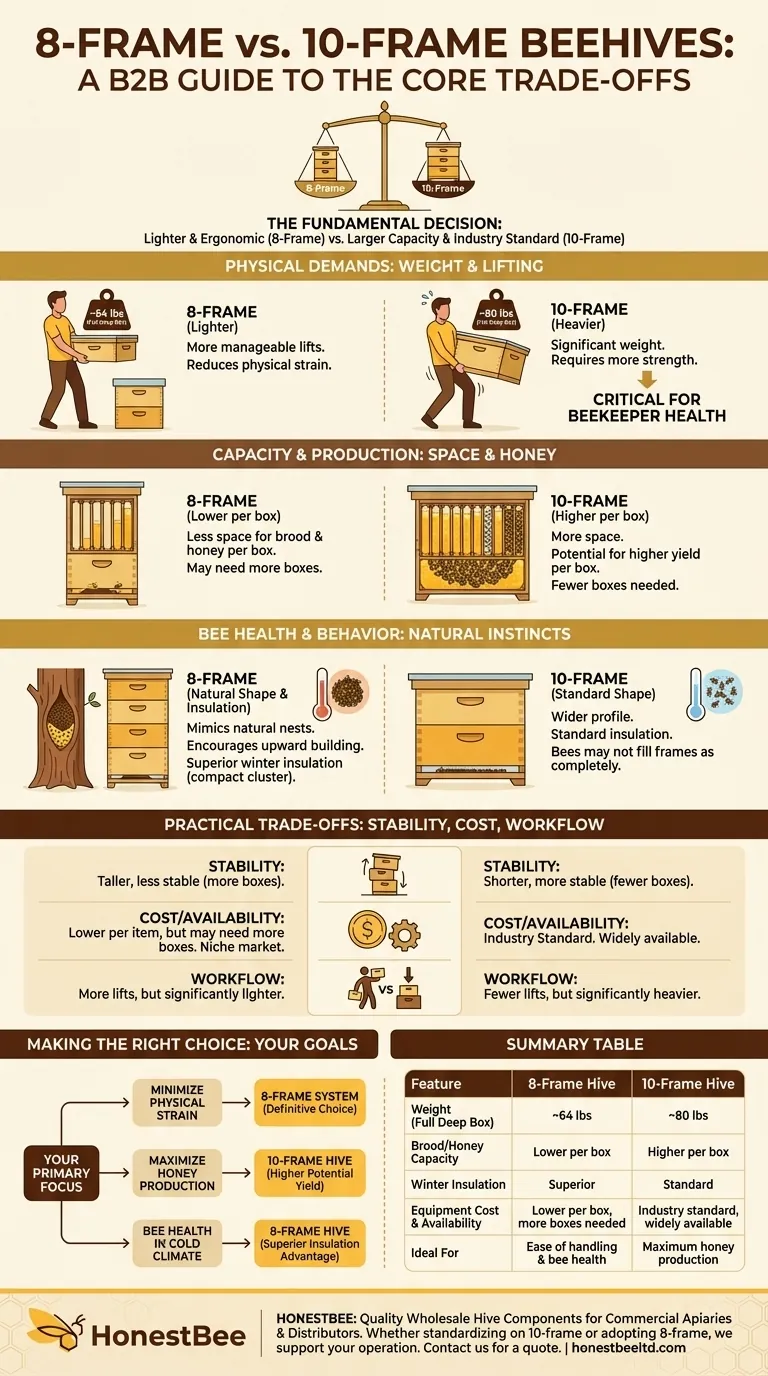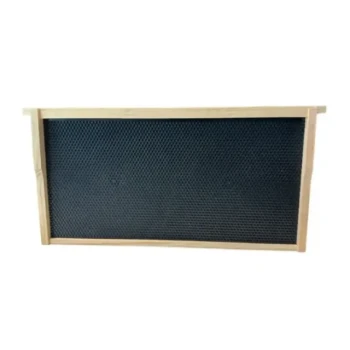The choice between an 8-frame and a 10-frame beehive is one of the most fundamental decisions a beekeeper makes. The primary difference comes down to a direct trade-off: the lighter, more manageable weight of the 8-frame system versus the larger honey and brood capacity of the 10-frame system. Your physical ability, beekeeping goals, and local climate will ultimately determine the right choice for you.
The decision is less about which hive is objectively "better" and more about which system is better aligned with you as a beekeeper. You are choosing between a lighter, more bee-centric design (8-frame) and a heavier, production-focused industry standard (10-frame).

The Core Difference: Weight vs. Space
The most immediate and impactful distinction between these two systems is their size and weight when full. This factor influences every interaction you will have with your hive.
The Physical Demands of Lifting
A core task in beekeeping is lifting hive bodies (boxes) for inspections and honey harvesting. The weight difference here is significant and should not be underestimated.
A full 10-frame deep hive body can weigh 80 pounds or more, while a medium box can be around 50 pounds. This is a substantial amount of weight to lift safely and steadily.
In contrast, a full 8-frame deep box is much more manageable at around 64 pounds, with a medium box weighing about 40 pounds. This reduction in weight can be the deciding factor for many beekeepers.
Capacity for Brood and Honey
The 10-frame hive body, being wider, holds more frames. This directly translates to more space for the queen to lay eggs and for the colony to store honey and pollen.
This additional space can lead to a larger bee population and potentially higher honey production per box. Because there is more room, a 10-frame hive may not need to be stacked as tall as an 8-frame hive to accommodate the same size colony.
How Hive Size Impacts Bee Health and Behavior
Beyond the beekeeper's convenience, the internal dimensions of the hive affect how the bees live and work. The narrower profile of the 8-frame hive is often considered more aligned with a colony's natural instincts.
A More "Natural" Shape
Wild honey bees tend to build their nests in tall, narrow cavities like hollow trees. The 8-frame hive more closely mimics these dimensions.
This encourages the bees to build upwards, a natural tendency, and they often fill the frames more completely before moving to the next box.
Winter Survival and Insulation
The compact nature of an 8-frame hive is a distinct advantage in colder climates. The smaller, squarer cluster of bees loses less heat.
This superior insulation makes it easier for the colony to maintain its temperature through the winter and allows the cluster to more easily access its honey stores.
Understanding the Practical Trade-offs
Choosing a hive system involves balancing benefits and drawbacks. Understanding these trade-offs is key to avoiding future frustrations.
Overall Hive Height and Stability
Because an 8-frame hive has less space per box, a strong colony will require more boxes to be stacked vertically.
This can result in a taller, less stable hive that is more susceptible to being tipped over by wind or animals.
Equipment Cost and Availability
The 10-frame hive is the long-standing industry standard in many regions. This often means equipment is more widely available from suppliers and other local beekeepers.
While 8-frame components are typically cheaper on a per-item basis, you may need to purchase more boxes over time.
Inspection Workflow
Inspecting a 10-frame hive means working through fewer, but heavier, boxes. An 8-frame hive requires lifting more boxes, but each one is significantly lighter. Your preference will depend on whether you prioritize fewer lifts or lighter lifts.
Making the Right Choice for Your Goals
There is no single correct answer. The best hive is the one you can manage effectively and that suits your specific environment and objectives.
- If your primary focus is minimizing physical strain: The lighter weight of the 8-frame system is the definitive choice.
- If your primary focus is maximizing honey production: The larger capacity of the 10-frame hive offers a higher potential yield per box.
- If your primary focus is bee health in a cold climate: The superior insulation of the 8-frame hive provides a clear advantage for winter survival.
Ultimately, choosing the right equipment is the first step in creating a system that works for both you and your bees.
Summary Table:
| Feature | 8-Frame Hive | 10-Frame Hive |
|---|---|---|
| Weight (Full Deep Box) | ~64 lbs | ~80 lbs |
| Brood/Honey Capacity | Lower per box | Higher per box |
| Winter Insulation | Superior (better for cold climates) | Standard |
| Equipment Cost & Availability | Lower per box, may need more boxes | Industry standard, widely available |
| Ideal For | Beekeepers prioritizing ease of handling & bee health | Beekeepers prioritizing maximum honey production |
Ready to build your ideal apiary?
Choosing the right hive is the first step to a successful season. At HONESTBEE, we supply commercial apiaries and beekeeping equipment distributors with the high-quality, durable hive components they need to thrive.
Whether you're standardizing on 10-frame equipment or adopting the 8-frame system for its ergonomic benefits, we have the wholesale supplies to support your operation.
Contact our team today to discuss your hive equipment needs and request a wholesale quote.
Visual Guide

Related Products
- Professional In-Hive Bee Feeder HONESTBEE Frame for Beekeeping
- Professional Hive Top Bee Feeder for Beekeeping
- Long Langstroth Style Horizontal Top Bar Hive for Wholesale
- Assembled Wooden Bee Frames with Beeswax Foundation Ready to Use by HONESTBEE
- Heavy-Duty Stainless Steel Clip-On Frame Perch
People Also Ask
- What are the two most popular types of honey bee feeders? A Guide to Frame and Bucket Feeders
- How does the design of Langstroth frames make them easier to operate? Leverage Bee Space for Efficient Hive Management
- What are the standard dimensions for Langstroth beehive frames? Choose the Right Size for Your Apiary
- Where should a bee feeder be placed? The Essential Guide to Hive Safety & Efficiency
- How do I keep bees from drowning in my frame feeder? Essential Tips for a Safe Hive



















